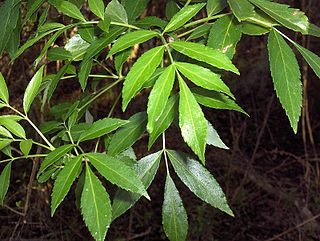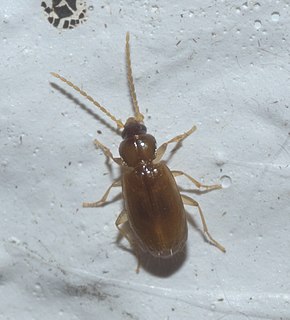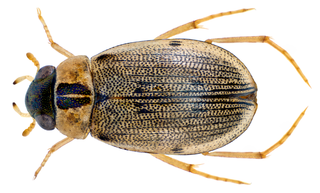
Hydrophilidae, also known colloquially as water scavenger beetles, is a family of beetles. Aquatic hydrophilids are notable for their long maxillary palps, which are longer than their antennae. Several of the former subfamilies of Hydrophilidae have recently been removed and elevated to family rank; Epimetopidae, Georissidae, Helophoridae, Hydrochidae, and Spercheidae. While the majority of hydrophilids are aquatic, around a third of described species are terrestrial, mostly belonging to the subfamily Sphaeridiinae.

Fraxinus caroliniana, the pop ash, Florida ash, swamp ash, Carolina ash, or water ash, is a species of ash tree native from Cuba through the subtropical southeastern United States from southern Virginia to Texas. It was originally described by the botanist Philip Miller. It is a small tree about 40 ft. Leaves are compound, opposite, 7–12 in long, leaflets 5–7 in, ovate to oblong, coarsely serrate or entire, 3–6 in long, 2–3 in wide. Fruit is frequently 3-winged (samara) with flat seed portion; seed sometimes a bright violet color. It is the smallest of eastern North American ash species, wood light, soft, weak, 22 lbs./cu.ft. Typical to coastal swamps and subtropical lowlands. Like other species in the section Melioides, Fraxinus caroliniana is dioecious, with male and female flowers produced on separate individuals.

Micratopus is a genus of ground beetles in the family Carabidae. There are about five described species in Micratopus.
Carabus exiguus is a species of black-coloured ground beetle in the Carabinae subfamily that is endemic to China.

Berosus is a genus of beetles in the family Hydrophilidae, the water scavenger beetles. The genus contains 273 species. It is distributed worldwide.
Berosus chevrolati is a species of hydrophilid beetles from Cuba.

Berosus infuscatus is a species of hydrophilid beetle from the United States, Mexico and Cuba.
Berosus interstitialis is a species of hydrophilid beetles from the Bahamas, Haiti, Guadeloupe, the U.S. Virgin Islands, Puerto Rico and Cuba.
Berosus metalliceps is a species of hydrophilid beetles from the United States, Mexico, the Bahamas and Cuba.
Berosus peregrinus is a species of hydrophilid beetles from Canada, the United States and Cuba.
Berosus quadridens is a species of hydrophilid beetles from Mexico, Guatemala, Nicaragua, Costa Rica and Cuba. It was previously considered a synonym of Berosus truncatipennis.
Berosus trilobus is a species of hydrophilid beetles from the Dominican Republic and Cuba.
Berosus undatus is a species of hydrophilid beetles from the United States, Mexico, the Lesser Antilles and Cuba.
Berosus aculeatus is a species of hydrophilid beetle native to the United States and Cuba. It was originally described by John Lawrence LeConte in 1855 and is characterized by prolonged apices of its elytra.

Berosus sayi is a species of hydrophilid beetles native to the United States. It is a synonym of Berosus striatus, which was originally described by Thomas Say in 1825, and females can be characterized by a small tooth on the suture near the apex of each elytron.

Berosus youngi is a species of water scavenger beetle found in the United States.
Berosus moerens is a species of water scavenger beetle in the family Hydrophilidae. It is found in Central America.

Berosus pulchellus, is a species of water scavenger beetle found in Oriental, Australasian, Afrotropical and Palaearctic regional countries such as India, Sri Lanka, Hong Kong, Japan, Iran, Cambodia and Australia.
Xyleborinus exiguus, is a species of weevil widely distributed throughout the Old World tropics and introduced to African and South American countries.
Berosus amoenus is a species of hydrophilid beetle endemic to the Northern Territory (Australia) which was first described in 1987 by Chris H.S. Watts.








